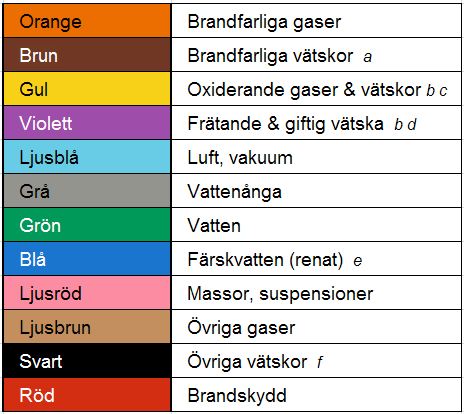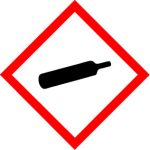SS741:2017 edition 8:
Labelling of gas, liquid and ventilation installations | Collinder®
New edition from August 2017 for pipe labelling with CLP/GHS. The complete standard can be can be ordered from the SIS publishing house.
Tips: There are some AFS that are related to SS741 and set requirements for pipe labelling:
- AFS2014:40 Signs and signals (amendment to AFS 2008:13)
- AFS2014:43 Chemical risks at work (amendment to AFS 2011:19)
The following is a summary of the marking colours and the main points of SS 741:2017.
4 General requirements
Marking (including colour marking) must be clearly visible and ensure that confusion does not occur. The labelling should be durable and resistant to the environment in which it is used. For example, chemical resistance, temperature and UV radiation should be considered.
The labelling information shall be affixed to tapes, labels, plates, etc. which are securely attached to pipelines and containers and to or adjacent to components.
5 Labelling of pipelines
The labelling shall, in addition to 5.3 Flow direction arrow, contain:
- 5.1 Market text
- 5.2 Labelling colour
- 5.4 Colour pictogram
- 5.5 Other labelling
- 5.6 Placement
- 5.7 Size of the labelling
5.1 Market text
- Product name (plain text for dangerous substances) or functional description.
- The contents of the pipeline must not be described by chemical formula alone.
- On a pipeline used for different products with the same hazardous characteristics, the product names may be indicated by a collective name.
- If necessary, values of pressure, temperature, chemical formula, etc. are also given.
- Supply and discharge pipelines shall be labelled with Supply (or To) and Return (or From) respectively.
- Pipelines may also be labelled with pipe numbers where appropriate.


5.2 Labelling colour
a) Flammable liquid: Flash point < = +100°C. Also pyrophoric liquids, organic peroxides and self-reactive substances and mixtures are brown.
b) For toxic liquids and for oxidising gases and liquids new colours apply from. SS 741:2013.
c) Hydrogen peroxide with concentration ≥ 20 % shall be labelled with yellow colour.
d) Also ammonia, both in liquid and gas phase.
From. SS741:2017, violet colour also applies to toxic and corrosive gases.
e) Blue colour for water is used in installations where both fresh water and sea/marine water are present. Blue colour is also used for specially treated water, e.g. feed water, deionised/distilled water or similar, and for the final product of clean water in treatment plants.
f) Black colour is also used for sewage and storm water pipes or water with a high admixture of other liquids, for example, refrigeration systems with a glycol mixture above 25%.
5.5 Other labelling
If necessary, indicate:
- technical data, such as concentration, pressure, temperature and pH. Data shall be expressed in units where appropriate.
- pipe number (process functional identification)
- category and inspection class
Piping with contents intended for fire-fighting purposes shall be labelled with a fire protection symbol.
5.6 Placement
Labelling shall be placed in a conspicuous place and in such a way as to avoid confusion
- for main and group shut-off valves, shunt groups and other switching options
- for appliance connections
- in the case of wall and floor penetrations, at least once in each room
- at branches
Accessible pipes above the ceiling should also be labelled as above.
5.7 Size of the labelling
No sign shall have a text height less than 6 mm. For all characters, the text height shall be
- at least 12 mm for pipes with outer diameter ≥ 25 mm
- at least 6 mm for pipes with outer diameter < 25 mm
The width of the labelling shall be
- at least 150 mm for pipes with outer diameter ≥ 25 mm
- at least 75 mm for pipes with outer diameter < 25 mm
Templates for printing your own Flo-Code labels
Flo-Code template 160 mm:

